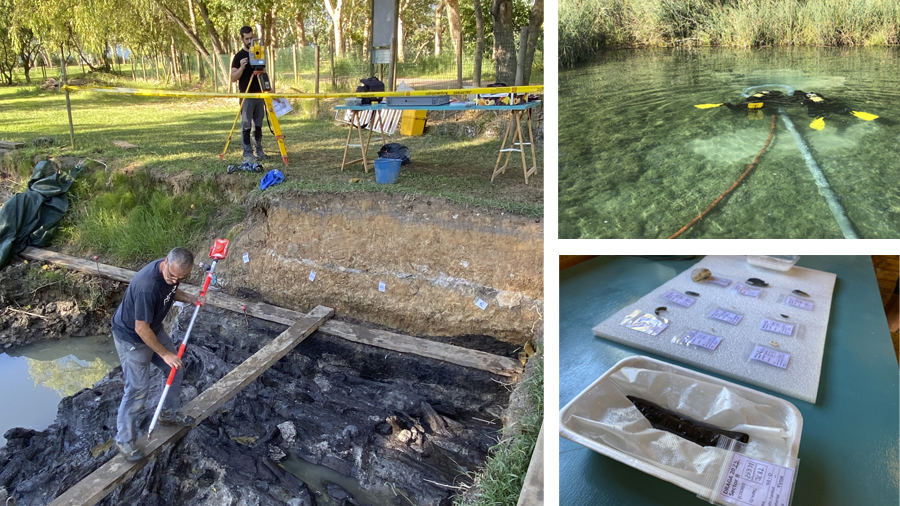La Draga's exceptionally conserved huts dating back 7,300 years now documented
The archaeological digs conducted this year at La Draga in Banyoles have led researchers to document extremely well-conserved wooden structural building elements. The work forms part of the four-year archaeological and palaeontological research project (2022-2025) dedicated to the Neolithic site of La Draga and coordinated by the Archaeological Museum of Banyoles.

The work concentrated on the northernmost area of the site, known as Sector B, which has the particularity of having better conditions for the preservation of organic matter. Until now, it is in this sector where the clearest architectural proof of the wooden huts built by the ancient inhabitants of La Draga exists, and also where a greater number of tools and utensils made from wood and plant fibres has been found.
Excavations in Sector B have resumed after a ten-year hiatus, during which time work had been directed towards other, lesser-known areas of the settlement. In this sector, a surface area of twelve square metres has been opened up which, in addition to allowing research to continue on the habitat structures uncovered in previous years, will allow for the recording and monitoring of the state of conservation of the wooden remains, which are some 7,200 years old.
The co-directors of the dig, Toni Palomo and Raquel Piqué (UAB) and Xavier Terradas (CSIC), explained that "the work at the site of La Draga has made it possible to document structural elements of wooden constructions in a very good state of preservation. These are mainly large wooden planks measuring more than three metres long that occupy practically the entire surface of the excavated area. The excavation process should allow us to make very precise interpretations about the shape of these huts, the construction techniques and the time of their construction, as well as their relationship with areas excavated in previous campaigns".
The tasks of monitoring the state of preservation of the organic material are part of the European research project "WOODPLAKE. Archaeological dwellings on wooden props in European Mediterranean lakes: strategies for their exploitation, monitoring and conservation". This project focuses on establishing conservation policies for these unique and important European heritage sites and facing the climatic challenges that are foreseen in the near future. The project is funded by the State Research Agency within the framework of the European programme Joint Projects in Cultural Heritage (JPICH): Conservation, Protection and Use, of which La Draga is a partner, together with the Italian lake sites of the Bolseno and Mezzano lakes.
At the same time, the campaign carried out two archaeological and palaeo-ecological excavations on the western shore of Lake Banyoles, both on land and underwater. Soundings were taken on the western shore of the lake, within the municipality of Porqueres. In this case, the objective was to obtain new sedimentological and palaeoenvironmental data that should enable the team of researchers from La Draga to reconstruct the environmental dynamics of the lake during the Holocene period and confirm the possible presence of other prehistoric occupations in this area. The surveys carried out have documented highly interesting evidence to reconstruct what the environment was like in prehistoric times and to contextualise findings made in previous surveys, when evidence of use of the area was documented some 5,000 years ago, more than 2,000 years after the settlement of La Draga.
Underwater surveys have also been carried out on the western shore of the lake, in the area between Freixenet Point and Cuaranya Point. The work has made it possible to document large areas of peaty sediment with a high presence of preserved organic matter such as, for example, remains of wood. The analysis of the samples taken provides a better understanding of the dynamics of the prehistoric and historical settlement of the lake.
The aim of all the archaeological digs is to complete the knowledge that is gradually being generated about the farming communities that settled in the lake at the beginning of the Neolithic period, some 7,200 years ago, their way of life and social organisation, the geomorphology of the lake basin and the landscape that surrounded them.
The archaeological dig campaign is part of a four-year archaeological and palaeontological research project for the period 2022-2025, approved by the Directorate General for Cultural Heritage of the Catalan Government and coordinated by the Archaeological Museum of Banyoles. This project is carried out in collaboration with the Universitat Autònoma de Barcelona (UAB), the Consejo Superior de Investigaciones Científicas (CSIC-IMF Barcelona), the Museu d'Arqueologia de Catalunya (MAC), through researchers from the Barcelona headquarters and the Centre d'Arqueologia Subaquàtica de Catalunya (CASC), which also provides its equipment to enable advanced and professionalised underwater exploration. Researchers from the Catalan Institute of Human Palaeoecology and Social Evolution (IPHES) and students from the UAB Campus of Archaeology and Palaeontology, as well as other students, are also participating in the excavation and prospecting work. The differentiated nature and objectives of these institutions and researchers allow for a more complete approach to the uniqueness of the site, making it possible to carry out different research tasks, train new researchers, conserve the remains and disseminate the data.
The digs at La Draga and the research activities carried out are funded by the Archaeological Museum of Banyoles, the Ministry for Culture of the Catalan Government, the CSIC, the UAB and the MAC, as well as the Spanish Ministry for Science and Innovation.